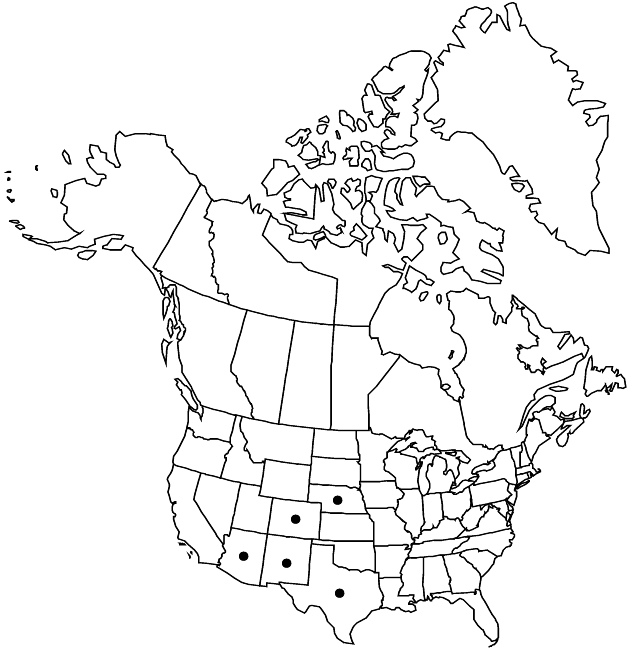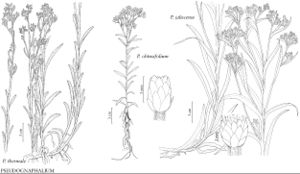Difference between revisions of "Pseudognaphalium jaliscense"
Opera Bot. 104: 147. 1991.
FNA>Volume Importer |
imported>Volume Importer |
||
| (3 intermediate revisions by 2 users not shown) | |||
| Line 8: | Line 8: | ||
}} | }} | ||
|common_names=Jalisco rabbit-tobacco | |common_names=Jalisco rabbit-tobacco | ||
| + | |special_status={{Treatment/ID/Special_status | ||
| + | |code=F | ||
| + | |label=Illustrated | ||
| + | }} | ||
|basionyms={{Treatment/ID/Basionym | |basionyms={{Treatment/ID/Basionym | ||
|name=Gnaphalium jaliscense | |name=Gnaphalium jaliscense | ||
|authority=Greenman | |authority=Greenman | ||
| + | |rank=species | ||
|publication_title=Proc. Amer. Acad. Arts | |publication_title=Proc. Amer. Acad. Arts | ||
|publication_place=39: 96. 1903 | |publication_place=39: 96. 1903 | ||
| Line 38: | Line 43: | ||
-->{{#Taxon: | -->{{#Taxon: | ||
name=Pseudognaphalium jaliscense | name=Pseudognaphalium jaliscense | ||
| − | |||
|authority=(Greenman) Anderberg | |authority=(Greenman) Anderberg | ||
|rank=species | |rank=species | ||
| Line 52: | Line 56: | ||
|publication title=Opera Bot. | |publication title=Opera Bot. | ||
|publication year=1991 | |publication year=1991 | ||
| − | |special status= | + | |special status=Illustrated |
| − | |source xml=https:// | + | |source xml=https://bitbucket.org/aafc-mbb/fna-data-curation/src/2e0870ddd59836b60bcf96646a41e87ea5a5943a/coarse_grained_fna_xml/V19-20-21/V19_699.xml |
|tribe=Asteraceae tribe Gnaphalieae | |tribe=Asteraceae tribe Gnaphalieae | ||
|genus=Pseudognaphalium | |genus=Pseudognaphalium | ||
Latest revision as of 19:54, 5 November 2020
Annuals or biennials, 30–70 cm; taprooted. Stems (branched among heads) densely and persistently loosely woolly-tomentose-sericeous, not glandular. Leaf blades narrowly lanceolate to nearly linear, 3–10 cm × 3–6 mm, bases not clasping, decurrent 4–8 mm, margins flat or slightly revolute, faces concolor, tomentose-sericeous (bases of hairs enlarged), sessile-glandular beneath tomentum. Heads in corymbiform arrays. Involucres campanulate, 5–6 mm. Phyllaries in 5–6(–7) series, white (opaque, dull), ovate or elliptic (keeled, apiculate), glabrous. Pistillate florets (80–)115[–180]. Bisexual florets (6–)8–12[–30]. Cypselae weakly ridged, papillate-roughened or smooth.
Phenology: Flowering Jul–Oct.
Habitat: Grasslands, chaparral, openings in oak-pine-juniper, oak, and ponderosa pine woodlands, roadsides, disturbed sites
Elevation: 1500–2300 m
Distribution

Ariz., Colo., Nebr., N.Mex., Tex., Mexico.
Discussion
Pseudognaphalium jaliscense is recognized by its relatively long, narrow, concolor to weakly bicolor leaves with non-clasping, short-decurrent bases, relatively large heads with white, opaque, dull phyllaries, and relatively large numbers of pistillate and bisexual florets. Counts of pistillate and bisexual florets from the United States collections are mostly 90–115 and (6–)8–12 (fewer than in Mexico).
Selected References
None.
